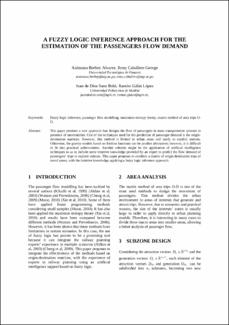Mostrar el registro sencillo del ítem
A Fuzzy Logic Inference Approach for the Estimation of the Passengers Flow Demand
| dc.contributor.author | Berbey Álvarez, Aranzazu | |
| dc.contributor.author | Caballero, Rony | |
| dc.contributor.author | Sanz Bobi, Juan de Dios | |
| dc.contributor.author | Galán, Ramón | |
| dc.date.accessioned | 2017-08-01T20:43:05Z | |
| dc.date.accessioned | 2017-08-01T20:43:05Z | |
| dc.date.available | 2017-08-01T20:43:05Z | |
| dc.date.available | 2017-08-01T20:43:05Z | |
| dc.date.issued | 2016-07-02 | |
| dc.date.issued | 2016-07-02 | |
| dc.identifier.uri | http://ridda2.utp.ac.pa/handle/123456789/2409 | |
| dc.identifier.uri | http://ridda2.utp.ac.pa/handle/123456789/2409 | |
| dc.description | This paper presents a new approach that designs the flow of passengers in mass transportation systems in presence of uncertainties. One of the techniques used for the prediction of passenger demand is the origin- destination matrices. However, this method is limited to urban areas and rarely to explicit stations. Otherwise, the gravity models based on friction functions can be another alternative; however, it is difficult to fit into practical achievements. Another solution might be the application of artificial intelligence techniques so as to include some intuitive knowledge provided by an expert to predict the flow demand of passengers’ trips in explicit stations. This paper proposes to combine a matrix of origin-destination trips of travel zones, with the intuitive knowledge, applying a fuzzy logic inference approach. | en_US |
| dc.description.abstract | This paper presents a new approach that designs the flow of passengers in mass transportation systems in presence of uncertainties. One of the techniques used for the prediction of passenger demand is the origin- destination matrices. However, this method is limited to urban areas and rarely to explicit stations. Otherwise, the gravity models based on friction functions can be another alternative; however, it is difficult to fit into practical achievements. Another solution might be the application of artificial intelligence techniques so as to include some intuitive knowledge provided by an expert to predict the flow demand of passengers’ trips in explicit stations. This paper proposes to combine a matrix of origin-destination trips of travel zones, with the intuitive knowledge, applying a fuzzy logic inference approach. | en_US |
| dc.language | eng | |
| dc.language.iso | eng | en_US |
| dc.rights | https://creativecommons.org/licenses/by-nc-sa/4.0/ | |
| dc.rights | info:eu-repo/semantics/openAccess | |
| dc.subject | Fuzzy logic inference | en_US |
| dc.subject | passenger flow modelling | en_US |
| dc.subject | maximum entropy theory | en_US |
| dc.subject | matrix method of area trips O- D | en_US |
| dc.subject | Fuzzy logic inference | |
| dc.subject | passenger flow modelling | |
| dc.subject | maximum entropy theory | |
| dc.subject | matrix method of area trips O- D | |
| dc.title | A Fuzzy Logic Inference Approach for the Estimation of the Passengers Flow Demand | en_US |
| dc.type | info:eu-repo/semantics/article | |
| dc.type | info:eu-repo/semantics/publishedVersion |
